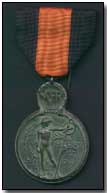Encyclopedia - Yser Medal
 The Belgian Yser Medal,
instituted on 18 October 1918, was awarded to Allied servicemen who took
part in fighting along the River Yser during the two-week period from 17-31
October 1914.
The Belgian Yser Medal,
instituted on 18 October 1918, was awarded to Allied servicemen who took
part in fighting along the River Yser during the two-week period from 17-31
October 1914.
Made of bronze the medal was considered secondary only to the Belgian War Cross 1914-1918. Its obverse features a naked helmeted man bearing a lance (indicating the halting of the advance of the enemy German force); to his right is the legend '17-31 Oct 1914'. Above both is the name 'Yser'.
The medal's reverse depicts a wounded lion on the battlefield with the letter 'A' at the head of the medal (signifying King Albert of the Belgians). The accompanying ribbon is red with wide black borders.
The Yser Medal was replaced by the similar Yser Cross in 1934. This medal was of similar design to the Yser Medal except that the medal was in the form of a cross (of four arms extended). The Yser Cross was issued as a replacement to the earlier Yser Medal upon application and upon payment of a fee; consequently relatively few were issued. The Yser Medal and the Yser Cross could not be worn together; it was a case of one or the other.
A "listening post" was an advanced post, usually in no-man's land, where soldiers tried to find out information about the enemy.
- Did you know?
